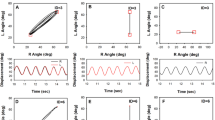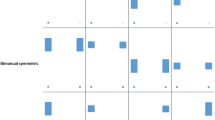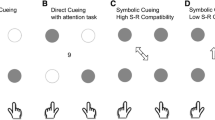Abstract
Task-switching paradigms have generally been used to investigate cognitive processes involved in decision making or allocating attention. This work extended the task-switching paradigm into the motor domain in order to investigate the consequences of an unexpected environmental perturbation on reaction time and movement time. Typically, task-switching paradigms have investigated consequences of rearranging task sets from one trial to the next; this work explored rearranging planned movements within the context of a single trial. Of particular interest was how the motor system reorganizes coordination patterns when reaching amplitude congruency is manipulated between the two hands. Results for Experiment 1 and the far distance in Experiment 2 indicated that reaction time switch costs were the smallest during congruent task-switch trials, where reaching amplitudes between the two hands were the same. This implies that a planned movement parameter for one hand is accessible for the other hand in the circumstance of an unexpected task switch. However, the reversed congruency effects found for the near distance in Experiment 2 suggest that the ability to capitalize on stored parameter information to decrease reaction time is dependent on environmental factors and task instructions. Movement time results showed that even if a movement with one hand is aborted in mid-execution, it can still influence the performance of the other hand during a task switch. This suggests that bimanual coordination can affect prehensile performance even though only one hand has a goal to achieve.






Similar content being viewed by others
References
Bingham GP, Hughes K, Mon-Williams M (2008) The coordination patterns observed when two hands reach-to-grasp separate objects. Exp Brain Res 184:283–293
Broadbent DE, Gregory M (1967) Psychological refractory period and the length of time required to make a decision. P Roy Soc Lond B Bio 168:181–193
Castiello U, Umilta C (1992) Splitting focal attention. J Exp Psychol Human 18:837–848
Diedrichsen J, Ivry RB, Hazeltine E, Kennerley S, Cohen A (2003) Bimanual interference associated with the selection of target locations. J Exp Psychol Human 29:64–77
Diedrichsen J, Nambisan R, Kennerley SW, Ivry RB (2004) Independent on-line control of the two hands during bimanual reaching. Eur J Neurosci 19:1643–1652
Dohle C, Ostermann G, Hefter H, Freund H-J (2000) Different coupling for the reach and grasp components in bimanual prehension movements. NeuroReport 11:3787–3791
Gentilucci M, Chieffi S, Scarpa M, Castiello U (1992) Temporal coupling between transport and grasp components during prehension movements: effects of visual perturbation. Behav Brain Res 47:71–82
Gilbert SJ, Shallice T (2002) Task switching: a PDP model. Cogn Psychol 44:297–337
Hazeltine E, Diedrichsen J, Kennerley SW, Ivry RB (2003) Bimanual cross-talk during reaching movements is primarily related to response selection, not the specification of motor parameters. Psychol Res 67:56–70
Jackson GM, Jackson SR, Kritikos A (1999) Attention for action: coordinating bimanual reach-to-grasp movements. Brit J Psychol 90:247–270
Kelso JS, Southard DL, Goodman D (1979) On the coordination of two-handed movements. J Exp Psychol Human 5:229–238
Koch I (2005) Sequential task predictability in task switching. Psychon B Rev 12:107–112
Marteniuk RG, MacKenzie CL, Baba DM (1984) Bimanual movement control: information processing and interaction effects. Q J Exp Psychol A 36:335–365
Mason AH (2008) Coordination and control of bimanual prehension: effects of perturbing object location. Exp Brain Res 188:125–139
Mason AH, Bruyn JL, Lazarus JC (2010) Bimanual coordination in children: manipulation of object size. Exp Brain Res 201:797–807
Monsell S (2003) Task switching. Trends Cogn Sci 7:134–140
Navon D, Miller J (2002) Queuing or sharing? A critical evaluation of the single-bottleneck notion. Cogn Psychol 44:193–251
Paulignan Y, MacKenzie CL, Marteniuk RG, Jeannerod M (1991a) Selective perturbation of visual input during prehension movements. 1. The effects of changing object position. Exp Brain Res 83:502–512
Paulignan Y, Jeannerod M, MacKenzie CL, Marteniuk RG (1991b) Selective perturbation of visual input during prehension movements. 2. The effects of changing object size. Exp Brain Res 87:407–420
Rogers RD, Monsell S (1995) Costs of a predictable switch between simple cognitive tasks. J Exp Psychol Gen 124:207–231
Rosenbaum DA, Weber RJ, Hazelett WM, Hindorff V (1986) The parameter remapping effect in human performance: evidence from tongue twisters and finger fumblers. J Memory Lang 25:710–725
Sherwood DE (2007) Separate movement planning and spatial assimilation effects in sequential bimanual aiming movements. Percept Motor Skill 105:501–513
Sigman M, Dehaene S (2006) Dynamics of the central bottleneck: dual-task and task uncertainty. PLoS Biol 4:1227–1238
Spijkers W, Heuer H, Kleinsorge T, Van der Loo H (1997) Preparation of bimanual movements with same and different amplitudes: specification interference as revealed by reaction time. Acta Psychol 96:207–227
Spijkers W, Heuer H, Steglich C, Klenisorge T (2000) Specification of movement amplitudes for the left and right hands: evidence for transient parametric coupling from overlapping-task performance. J Exp Psychol Human 26:1091–1105
Waszak F, Hommel B, Allport A (2003) Task-switching and long-term priming: role of episodic stimulus-task bindings in task-shift costs. Cogn Psychol 46:361–413
Wenderoth N, Van Dooren M, Vandebroek A, De Vos J, Vangheluwe S, Stinear C, Byblow WD, Swinnen SP (2009) Conceptual binding: Integrated visual cues reduce processing costs in bimanual movements. J Neurophysiol 102:302–311
Winer BJ, Brown DR, Michels KM (1991) Statistical principles in experimental design, 3rd edn. McGraw Hill, NY
Wylie G, Allport A (2000) Task switching and the measurement of “switch costs”. Psychol Res 63:212–233
Zanone PG, Kelso JS (1991) Relative timing from the perspective of dynamic pattern theory: stability and instability. In: Fagard J, Wolff PH (eds) The development of timing control and temporal organization in coordinated action: invariant relative timing, rhythms and coordination. North Holland, Oxford, pp 69–92
Author information
Authors and Affiliations
Corresponding author
Rights and permissions
About this article
Cite this article
Bernardin, B.J., Mason, A.H. Bimanual coordination affects motor task switching. Exp Brain Res 215, 257–267 (2011). https://doi.org/10.1007/s00221-011-2890-x
Received:
Accepted:
Published:
Issue Date:
DOI: https://doi.org/10.1007/s00221-011-2890-x




